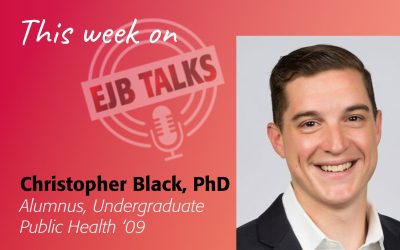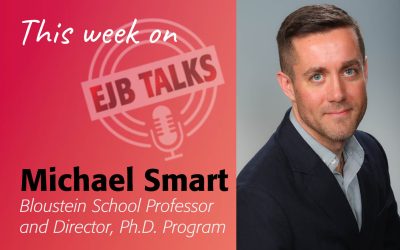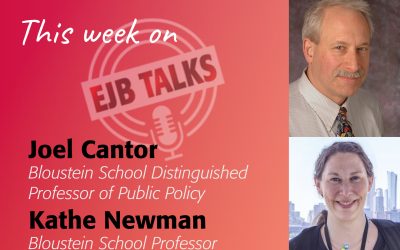The New Jersey/New York region is one of the most densely populated in the United States with some of the most widely traveled public transit systems. Thousands of New Jerseyans take NJ Transit bus and rail to New York City; thousands more crowd the New York bus and subway systems. These heavily-used systems have been flagged as possible reasons for the spread of COVID-19. Today on EJB Talks, Stuart Shapiro tackles the issue of public transit and safety measures our transit agencies may need to make to bring commuters back, the effect telecommuting will have on these transit systems, and the new dependence on online services will have on the future of work with Robert Noland, Distinguished Professor and Director of the Alan M. Voorhees Transportation Center at the Bloustein School.
Stuart Shapiro
Welcome to another episode of EJB Talks. I’m Stuart Shapiro, the Associate Dean of Faculty at the Bloustein School. And the purpose of this podcast is to talk with my colleagues about issues affecting people in New Jersey, the United States, and the world. In our last episode, we talked about the effects of COVID-19 and the economic dislocation on urban design. Today, we turn to another related field that’s covered by our highly ranked urban planning program, transportation. I’m talking to my colleague, Professor Bob Noland. Bob, can you tell us about the areas of transportation you study?
Robert Noland
Well, thank you, Stuart. So I study a lot of different areas of transportation. Probably a lot of it boils down to travel behavior, economic impacts, environmental impacts, safety impacts. A lot of our work is really just applied statistics, playing statistical models to understand transportation behavior.
Stuart Shapiro
So turning to COVID-19 and these crazy times we’re going through right now. It’s hit hardest in our cities. And one of the areas most affected will be public transit, where people crowd together. I know, hundreds of thousands of people take the New York City subways every day. Do you think people are going to return to public transit after all this is over?
Robert Noland
Well, that’s a very good question. I suppose, you know, there are always some people who have no option other than taking public transit. That’s probably especially true in New York City, which is very dependent on their public transit system, especially the subway. So the question is, will those people who have a choice, will they decide to drive or will it take transit and I think we really don’t know whether people be comfortable with that. It really depends on what sort of practices the transit agencies following and such. I will say that this is all going to be very difficult to figure out because the first thing that’s happening is we’re going to have a major economic recession, and that’s going to reduce use of public transit, regardless of, you know, people’s reaction or their fear of using public transit.
Stuart Shapiro
Right. And we’re also going through a crashing of gas prices, part of that is COVID related demand, but part of that is supply-side issues. If that lasts, that’s also going to affect the decisions about how people move from place to place, right?
Robert Noland
Yes, that probably would; again, for those who have a choice. They may realize that driving is cheaper now, and also, if there’s a recession, we won’t see as much traffic congestion, so they may be more likely to drive relative to taking transit. The more worrisome concern there is that people will make decisions on what type of vehicle to purchase when they make the next purchase, and they will not get as efficient a vehicle. We already know gasoline was already cheap before this crisis at about $50 a barrel or so.
And we’re already seeing a trend towards people buying larger vehicles. Given that our fuel economy regulations are set by vehicle class, this is actually not a good thing. It’s increasing our co2 emissions. Nevermind that the Trump administration tried to dismantle our policies to try to reduce carbon emissions but, this was still in effect that was happening.
Stuart Shapiro
From what you’re saying, it sounds to me–we’ve been hearing about, sort of, how the return to work is going to fuel inequality; that you know, people will have to go back to work that can’t work remotely, and others will be able to work from home like you and I. It sounds like the transportation differential will also fuel inequality here. The people that have to use public transit will crowd together in the trains and those of us that don’t have to will be free from that burden.
Robert Noland
That’s a possible outcome, I think. So it’s really dependent on the transit agencies, doing their best to have certain requirements; people wearing masks, making sure the trains and the stations are not crowded by just letting a certain amount of people in. Of course, that’s going to delay their trip, potentially, if there’s a lot of demand. I really don’t know how that’s going to be handled. You know, the obvious solution is to get a vaccine out there. And we don’t have to worry as much– I hope, about this–but there may be some residual fear of crowded spaces.
Stuart Shapiro
Yes, I think it’s human behavior. And human psychology indicates that there certainly might be. I mean, I go into the city and I think about whether I would drive or take New Jersey Transit and for the near future, I plan on driving.
Robert Noland
Okay. (laughing)
Stuart Shapiro
Despite my care for the environment, despite all of that.
Robert Noland
(laughing) The trains are probably empty, now. The trains going into Manhattan.
Stuart Shapiro
That’s true. I’m not going right now, going in a month or two. Right. Now, what about the fact that everything we’ve learned about working remotely and shopping remotely? How do you think that’s going to affect transportation decisions?
Robert Noland
So, that’s an interesting one. You know, people have been talking about working at home, telecommuting, whatever you want to call it, you know, for 35, 40 years. And, you know, what the research has shown is that this is kind of a, people might work at home part of the time instead of … a transient phenomenon. It’s not like someone makes a decision. Well, I’m just going to keep working at home from now on. And, you know, so there’s been a small percent of the population that’s working at home some of the time.
It’s certainly, you know, in my experience it’s certainly feasible. It saves me a couple of hours a day in commute time. It also makes me go a little bit bonkers at times. And, I get that you don’t get outside as much. And it’s those people–and this would, of course, change when schools and childcare reopen–it’s those people have children in the household that they have to look after that are really distracted. It’s difficult to work at home. But there are other distractions, you know, the dog barking; the lawn care people who come out and start mowing the lawn or blowing leaves or whatever. It’s a little bit, actually, noisier than being in the office at times. And so, there are these little annoyances that don’t think about when you don’t do it.
And so, you know, the other issue is, I think employers are going to have a decision to make; a lot of employers would love to not have to lease or buy as much office space, it would give them big cost savings. On the other hand, how comfortable do they feel with all this working at home? Is it affecting their productivity? Is it affecting the ability to communicate; you know, to have water cooler conversations and such that can pass information along. And these are unknowns as to how it’s going to vary by industry, how important these other effects are. But yeah, we’ve known for a long time that clustering people at a worksite or in an area can increase productivity. So, you know, again, I don’t know how that will be here.
Stuart Shapiro
At Bloustein, we’ve started to begin thinking a lot about the future of work and clearly, the future of work affects the future of transportation and the future of our social classes as well.
Robert Noland
You also asked about online services. I think we all have a story to tell about trying to order groceries or other items online right now. I was talking to one of our Ph.D. students about ordering from Walmart, he got some cat litter that he didn’t order so if anyone would like some, I’ll give you his name. (laughing) Obviously these companies are struggling right now. So it’s not the best example of efficient services.
You know, I don’t know how that will play out. This is certainly more expensive, I think than going to the store. So, it’s going to be a decision that people make in the future and some people may be turned off by how inefficient it is right now. So again, it’s a big unknown there as to how much it will increase.
Robert Noland
Yeah, maybe. Maybe? I don’t know.
Stuart Shapiro
It could go any of a number of directions. Switching gears a little bit. The aviation industry has been perhaps the most affected by COVID-19, outside of probably hotels and hospitality. What do you see for the future of aviation? Will it come back? Will people start flying again?
Robert Noland
That’s a very good question. I think again, part of it will be determined by how the airlines and the airports manage their crowding. I don’t think anyone would feel comfortable getting on a crowded plane right now. You know, most of them are flying empty, or very empty. So again, I would be reluctant to fly again until there’s a vaccine in place.
Stuart Shapiro
Yeah.
Robert Noland
I would imagine that when that does happen, there’s enough demand for travel, from long-distance travel and tourist travel, that the airlines will probably recover.
Stuart Shapiro
Yes, I think that’s right. I mean, also right now I think fresh in our mind is the fact that almost certainly air travel was a key vector of spreading this disease around the globe. And people aren’t going to forget that too quickly.
Robert Noland
And you know, people have always been concerned. They say, oh, I flew, you know, cross country a plane and I got home I got sick. Or from flying across the Atlantic or something. So there’s always, especially in the wintertime that concern about picking something up on a flight. And better air circulation–which eats up more fuel, by the way–can maybe help alleviate some of that.
Stuart Shapiro
It’s interesting. As with transit there are certain choices that private entities or state and local entities could make to mitigate these effects. And it will be interesting to see whether or not they do so.
Robert Noland
Well most of them will cost them money and knowing how our economy works, they probably won’t. At least not in the long run.
Stuart Shapiro
And of course, that’s where policy could step in and we could require some of these changes at least in the short term, as people gain more confidence in using transportation again,
Robert Noland
Yes.
Stuart Shapiro
All of these things impact the burning of fossil fuels–the decision whether or not to drive to work, the decision whether to drive or take public transit, or bike or walk, the decision to fly; and of course, burning fossil fuels is a key contributor to climate change. Do you think the changes taken in whole are likely to help or hurt the fight to curb global warming?
Robert Noland
Again, good question. I’m going to guess it probably won’t make any difference. You know, maybe a few more people work at home, but then if you have fewer people using transit and driving instead, it’s all going to balance out. The interesting thing I’ve observed is you see more people walking and obviously they’re walking around their neighborhood to try to get out of the house that they’ve been stuck in the house and there’s nowhere to go than to get in the car.
So I keep thinking, you know, people are actually discovering walking, they’re discovering their neighborhood. Maybe they will walk more for exercise. I don’t know if it’s going to affect their walking for trips and actual activities, because most people don’t live in neighborhoods where they can actually walk somewhere. But it might give people a sense of distance, we kind of know that people have a very bad sense of distance. If you say, oh, it’s only a one mile walk away, most people would think that’s unwalkable. Yet it’s only a 20-minute walk or so. So, people’s perceptions may change, at least in the short run. So I don’t know how to play out.
Stuart Shapiro
What are the biggest changes that you see in transportation going forward as a result of everything we’re going through right now?
Robert Noland
Well, the big change is going to be the big revenue hit to public transit right now. So, not only are they not getting their fare income–and obviously a lot of them have cut service because no one’s using the service. New Jersey Transit went to a weekend schedule at least for the trains. I don’t know, the bigger hit will come from the lack of state support because the state budgets have been hit. A lot of–not in New Jersey, but a lot of states–they have a sales tax base for their transit. So all of this has been hit obviously, and there will be some recovery of that as things open up eventually. But the recession that’s coming will also affect that. So, you know, without support to maintain these systems, there’s going to be reductions in service, basically.
Stuart Shapiro
Right. And it’s not like New Jersey Transit wasn’t already in need of significant infrastructure improvements before this started.
Robert Noland
Well, the capital expenses are usually distinct from the operating expenses. But yes, that’s going to be, to some extent, that would be an opportunity to do some of those major capital improvements if you have fewer people using the system. But, these projects take a while to plan.
Stuart Shapiro
Anything else you’d like to get in about transportation before we sign off?
Robert Noland
I guess the other issues you were mentioning, how airlines have possibly been a vector for spreading the virus and coming over from other countries and such; and that’s been the case. And even traveling within this country that’s been the case. Yeah, there’s been some debate is public transit a vector, also, by having the crowding; and there’s been quite a debate about that in New York City, for example. I don’t think that’s been determined yet. We’re trying to do a little analysis to kind of look at those issues. I would still suggest public transit probably did make things worse. But it’s probably a small effect. Driving also seems to give a positive effect also. So just having more mobility maybe has led to passing the virus on. Hard to say for sure now. I think once all the data is in place, we’ll have a better idea. What’s great about this right now there are all these open data sources being updated in real-time. So it gives us some ability to analyze these things quite quickly. I wish there were more data because some of it is not really appropriate for what we’re trying to do, but it’s suggestive of these sort of effects.
Stuart Shapiro
That’s interesting. The idea that mobility and us; our presence as a mobile society means also the virus can travel very easily.
Robert Noland
Yes.
Stuart Shapiro
Well, when you get done with that analysis, we can have you back on and talk some more about what you find.
Robert Noland
Okay!
Stuart Shapiro
In the meantime, a big thank you to Professor Noland for coming on today. Thanks, Bob.
Robert Noland
All right. Thank you, Stuart.
Stuart Shapiro
And I’d also like to thank as always our production team, Tamara Swedberg, Amy Cobb, and Karyn Olsen. We’ll be back next week with another talk with another expert from the Bloustein School. Thanks for listening.




